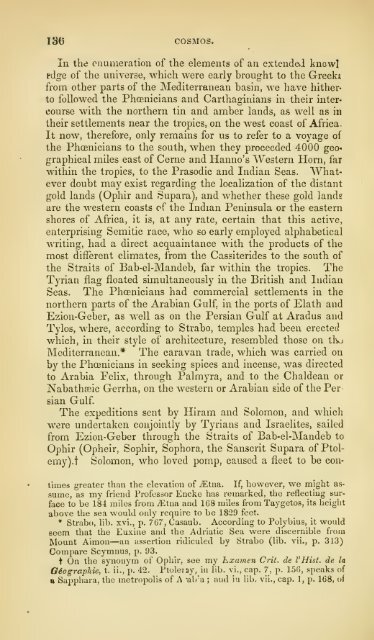See the complete document here
See the complete document here
See the complete document here
You also want an ePaper? Increase the reach of your titles
YUMPU automatically turns print PDFs into web optimized ePapers that Google loves.
13(5<br />
COSMOS.<br />
In <strong>the</strong> enumeration of <strong>the</strong> elements of an extended know!<br />
edge of <strong>the</strong> universe, which were early brought to <strong>the</strong> Greeki<br />
from o<strong>the</strong>r parts of <strong>the</strong> Mediterranean basin, we have hi<strong>the</strong>r*<br />
to followed <strong>the</strong> Phcenicians and Carthaginians in <strong>the</strong>ir inter-<br />
course with <strong>the</strong> nor<strong>the</strong>rn tin and amber lands, as well as in<br />
<strong>the</strong>ir settlements near <strong>the</strong> tropics, on <strong>the</strong> west coast of Africa.<br />
It now, <strong>the</strong>refore, only remains for us to refer to a voyage of<br />
<strong>the</strong> Phoenicians to <strong>the</strong> south, when <strong>the</strong>y proceeded 4000 geographical<br />
miles east of Cerne and Hanno's Western Horn, far<br />
within <strong>the</strong> tropics,<br />
to <strong>the</strong> Prasodic and Indian Seas. Whatever<br />
doubt may exist regarding <strong>the</strong> localization of <strong>the</strong> distant<br />
gold lands (Ophir and Supara), and whe<strong>the</strong>r <strong>the</strong>se gold lands<br />
are <strong>the</strong> western coasts of <strong>the</strong> Indian Peninsula or <strong>the</strong> eastern<br />
shores of Africa, it is, at any rate, certain that this active,<br />
enterprising Semitic race, who so early employed alphabetical<br />
writing, had a direct acquaintance with <strong>the</strong> products of <strong>the</strong><br />
most different climates, from <strong>the</strong> Cassiterides to <strong>the</strong> south of<br />
<strong>the</strong> Straits of Bab-el-Mandeb, far within <strong>the</strong> tropics. The<br />
Tyrian flag floated simultaneously in <strong>the</strong> British and Indian<br />
Seas. The Phoenicians had commercial settlements in <strong>the</strong><br />
nor<strong>the</strong>rn parts<br />
of <strong>the</strong> Arabian Gulf, in <strong>the</strong> ports of Elath and<br />
Ezion-Geber, as w^ell as on <strong>the</strong> Persian Gulf at Aradus and<br />
Tylos, w<strong>here</strong>, according to Strabo, temples had been erectec^<br />
which, in <strong>the</strong>ir style of architecture, resembled those on tkj<br />
Mediterranean,* The caravan trade, which was carried on<br />
by <strong>the</strong> Phoenicians in seeking spices and incense, was directed<br />
to Arabia Felix, through Palmyra, and to <strong>the</strong> Chaldean or<br />
Nabathseic Gerrha, on <strong>the</strong> western or Arabian side of <strong>the</strong> Per<br />
sian Gulf.<br />
The expeditions<br />
sent by Hiram and Solomon, and which<br />
were undertaken conjointly by Tyrians and Israelites, sailed<br />
from Ezion-Geber through <strong>the</strong> Straits of Bab-el-Mandeb to<br />
Ophir (Opheir, Sophir, Sophora, <strong>the</strong> Sanscrit Supara of Ptolemy).!<br />
Solomon, who loved pomp, caused a fleet to be con-<br />
times greater than <strong>the</strong> elevation of yEtna. If, however, we might assume,<br />
as my friend Professor Encke has remarked, <strong>the</strong> reflectiug surface<br />
to be 184 miles from Mtua. and 1G8 miles from its Taygetos, height<br />
above <strong>the</strong> sea would only require to be 1829 feet.<br />
*<br />
Strabo, lib. xvi., p. 767, Casaub. According to Polybius, it would<br />
Beem that <strong>the</strong> Euxine and <strong>the</strong> Adriatic Sea were discernible from<br />
Mount Aimon— an assertion ridiculed by Strabo (lib. vii., p. 313)<br />
Compare Scymnus, p. 93.<br />
t On <strong>the</strong> synonym of Ophir, see my hxamen Crit. de VHist. de la<br />
Giographie, t. ii., p. 42. Ptoleiay, in lib. vi., cap. 7, p. 156, speaks of<br />
a Sajiphara,<br />
<strong>the</strong> metropolis of A -ab-a and i-.i lib. ; vii., cap. 1, p. 168, of
















